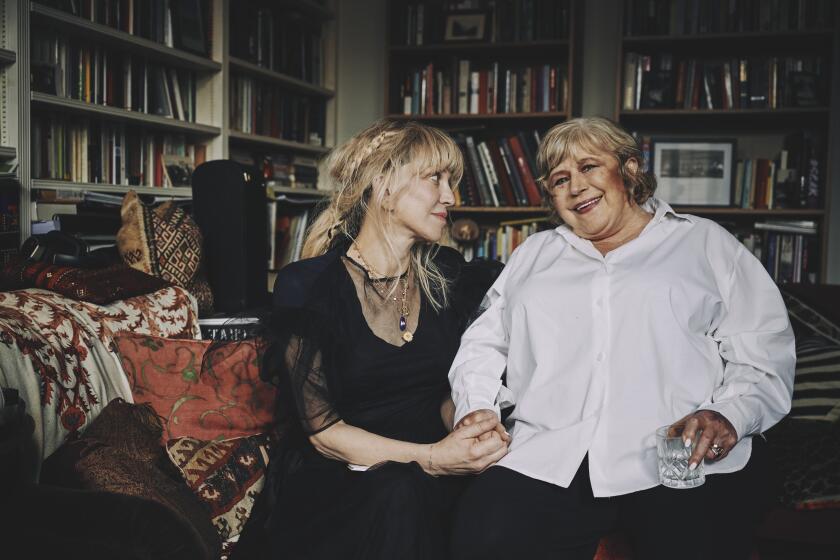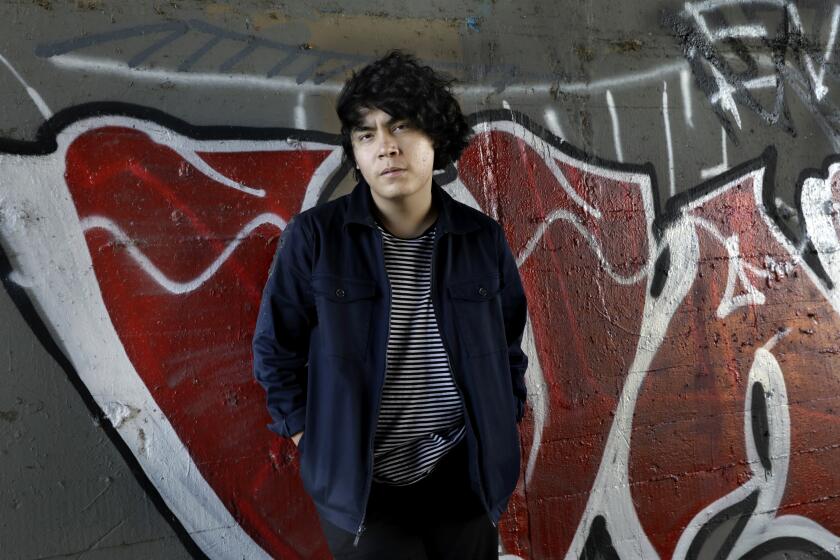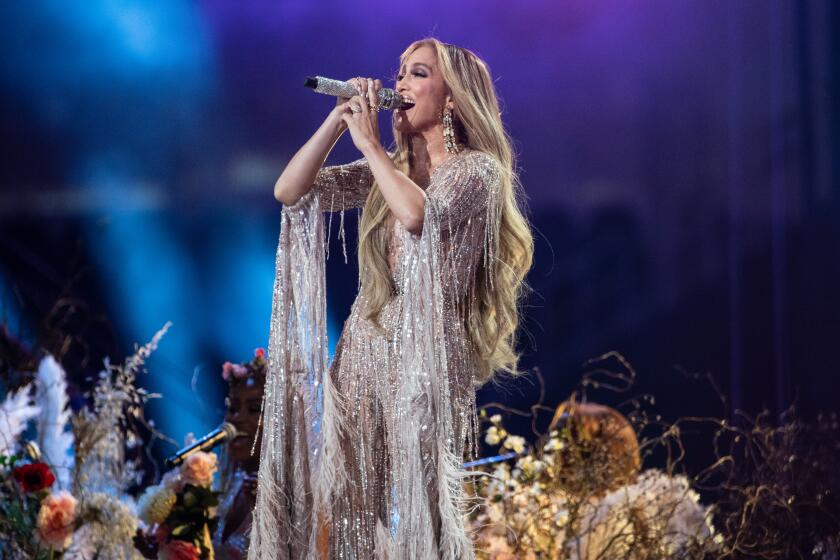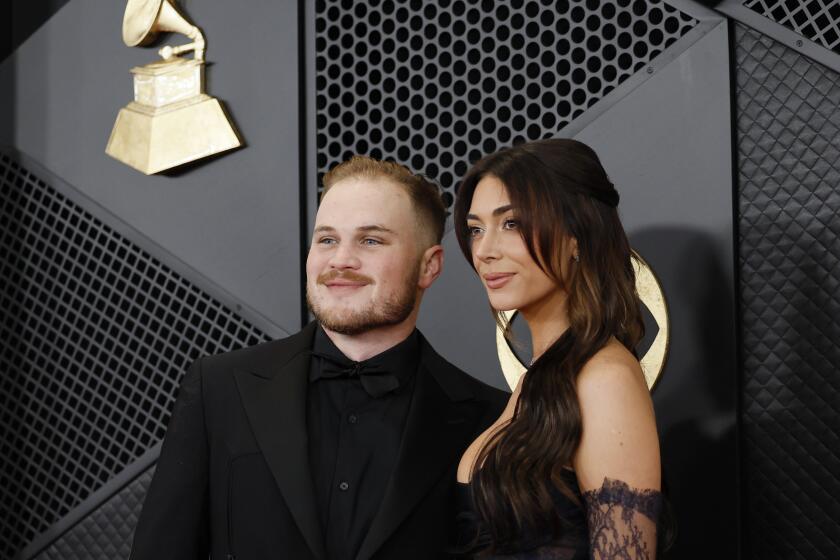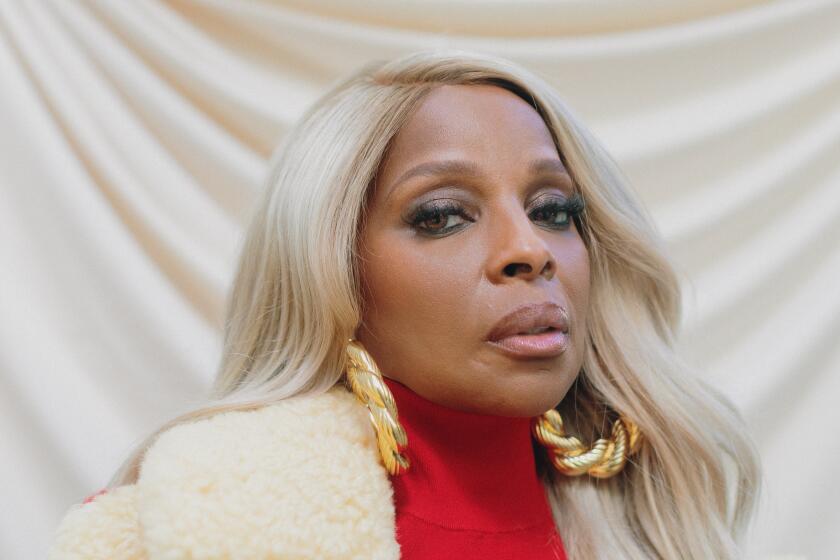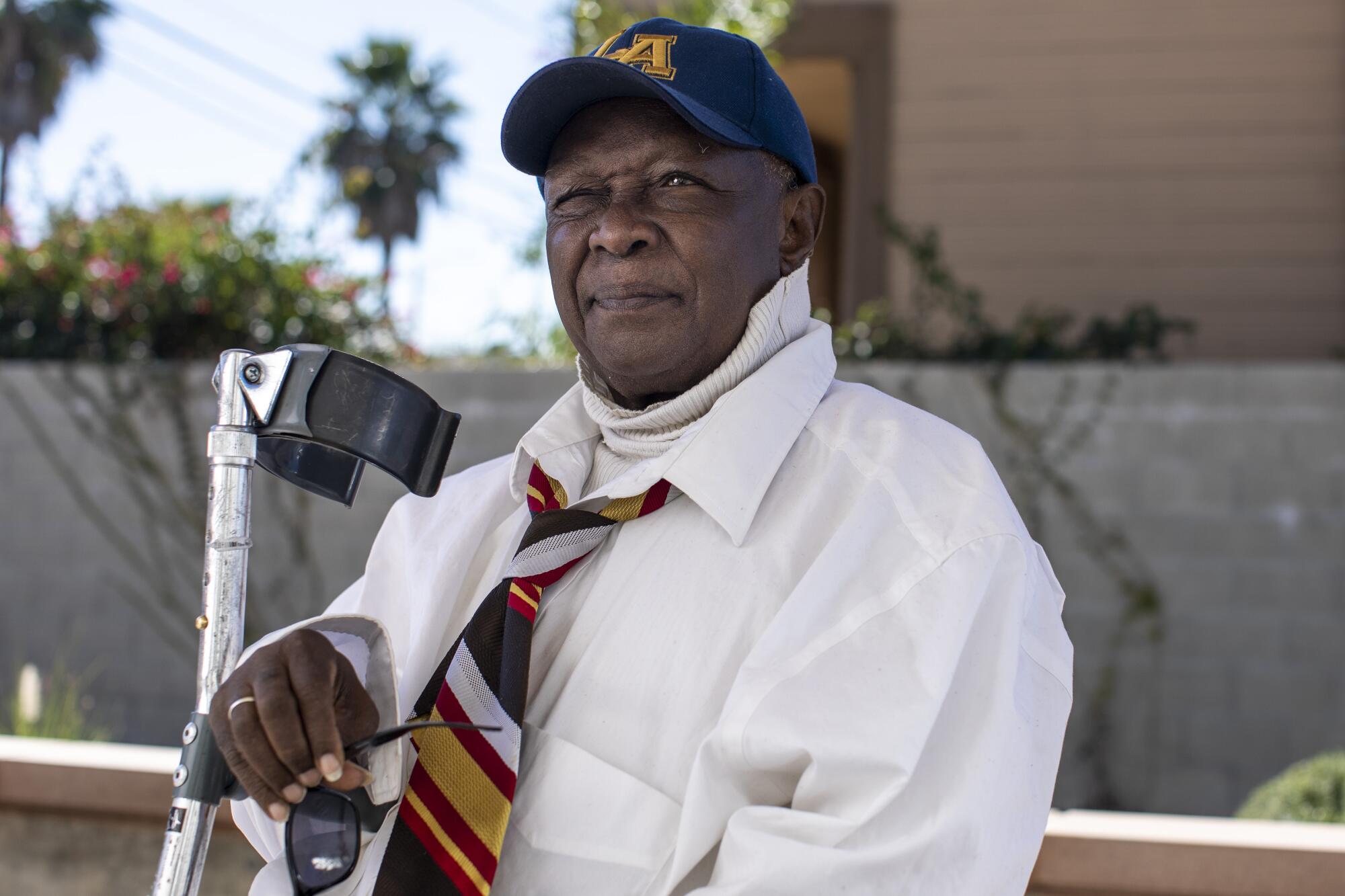
On the night of Jan. 26, 2014, Thomas Bangalter and Guy-Manuel de Homem-Christo of Daft Punk leapt onto the stage at Staples Center to accept the Grammy for album of the year.
Even though the French electronic duoâs faces were hidden behind white and gold robot masks, they couldnât hide their elation as they waved back to cheers from Jay-Z, Taylor Swift and Kendrick Lamar. Their album âRandom Access Memoriesâ and its smash single âGet Luckyâ were crowning achievements in a career of immaculately produced dance music, played at pop-star scale.
Meanwhile, somewhere in the flatlands of L.A., far from the limos and gowns at Staples Center, Eddie Johns bedded down for the night.
Johns doesnât remember exactly where in L.A. he was living back then, but it was almost certainly somewhere bleak. The Liberian-born singer, now 70, struggled with homelessness here for more than a decade; he had a stroke 10 years ago that left him unable to work and forced him onto the streets or into shelters.
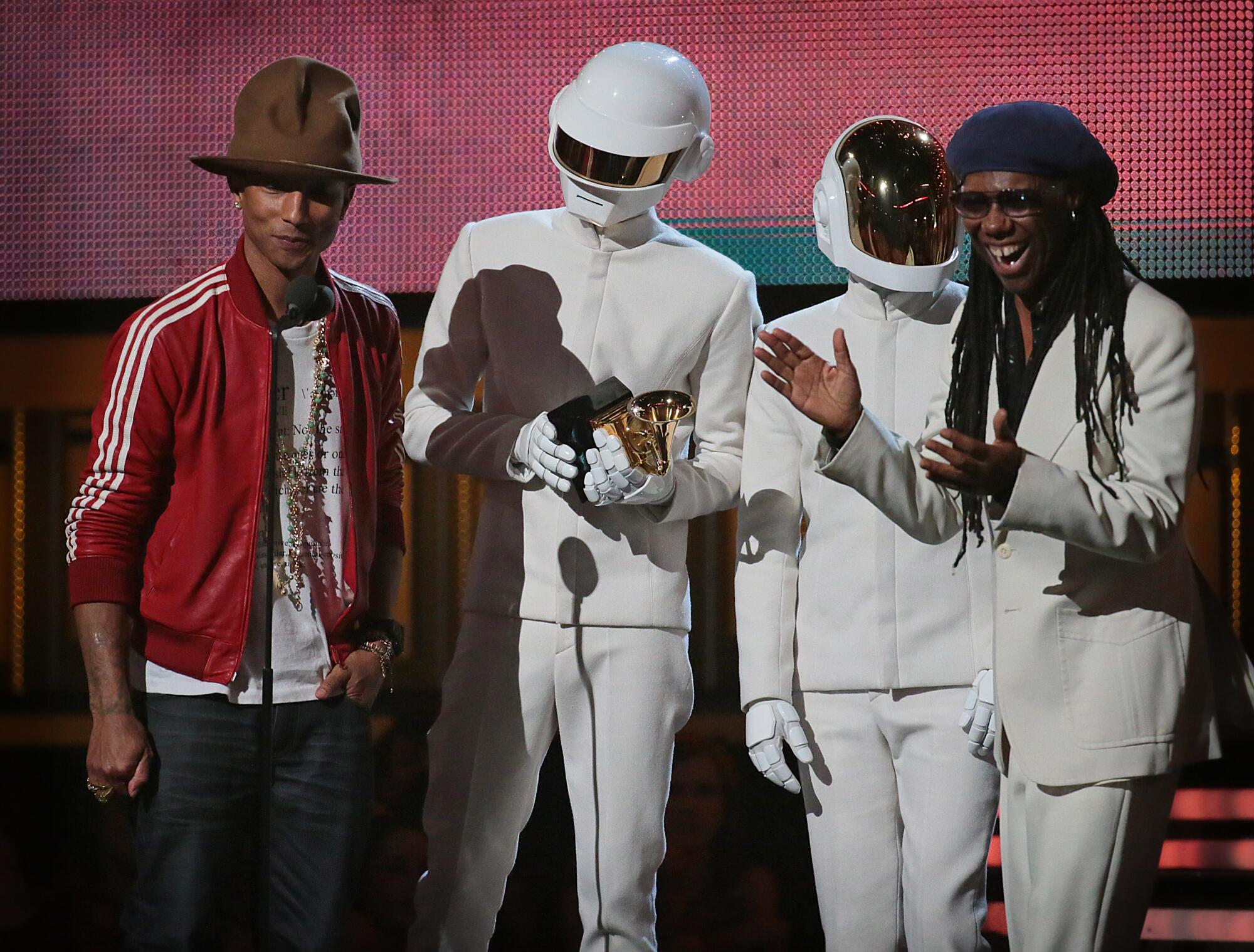
Four decades earlier, he helped put Daft Punk on the path to those Grammys.
In 1979, when he was 28, Johns released an album, âMore Spell on You,â with a punchy disco title track he recorded in Paris and released in Europe. Johnsâ pleading lyrics about a desperate love â âIâm gonna put a spell on you, because thatâs the only thing to do / So that youâll never get awayâ â rode an uptempo, brassy production. It didnât earn the singer much attention at the time. But when Daft Punk recorded its 2001 album âDiscovery,â the duo found it and heard something they liked.
They chopped the trackâs champagne-fizzy horn sections into short samples (a portion of a previously recorded song) and, as the band verifies, rearranged them into new hooks for the track âOne More Time.â That song became Daft Punkâs biggest hit to date and its first million-selling single. It grew the duo from a respected club-music act into one of the most popular electronic groups on earth. Pitchfork called âOne More Timeâ the fifth-best song of the 2000s, and Rolling Stone called âDiscoveryâ one of the 500 best albums of all time, in any genre.
Johns says he hasnât seen a dime from it.
Friends since the â90s, two of rockâs grandes dames gather to discuss Faithfullâs new album, âShe Walks in Beauty,â and their near-death experiences in 2020.
âI help Eddie use the computer sometimes, and he showed me some of his music,â said Alyssa Cash, who since September has been Johnsâ case manager at the supportive housing charity PATH. After Daft Punk announced its retirement in February, amid all the praise for their achievements, she wanted Johnsâ part to be remembered too.
âHe showed me his album cover, and when I found this video talking about how it was sampled by Daft Punk, it was like a lightbulb went off. âThatâs Eddie, this is his song.ââ
âI just hope I can get some credit, you know?â Johns told The Times (he is not listed as a songwriter on âOne More Timeâ). He wants his family and the world to know that, whatever else happened to him, his music was important: âIâd like to have something to give to my daughter.â

A representative for Daft Punk confirmed that they have, for years, paid royalties to officially license the sample of Johnsâ song. ââOne More Timeâ contains extracts of the recording âMore Spell on You.ââ the representative said. âDaft Life LTD. is paying royalties twice a year to the producer and owner of âMore Spell on You.â ⌠Per the agreement it is the duty of the producer of âMore Spell on Youâ to pay (part of such) semiannual payments to Eddie Johns.â
Subscribers get early access to this story
Weâre offering L.A. Times subscribers first access to our best journalism. Thank you for your support.
The rights to âMore Spell on Youâ â first released in France on the label PrĂŠsident â were acquired by a French label and publishing company, GM Musipro, that reissues vintage French rock and pop. Itâs where Daft Punk pays its royalties for permission to sample âMore Spell.â The firmâs founder, Georges Mary, confirmed via phone and email that his company does receive those payments from Daft Punk but did not specify an amount.
âWe have not heard from [Johns] since the day we acquired in 1995 a catalog from another label that featured this title,â Mary wrote. âWe have tried to do research on him, but without any result. For our part, we are going to study his file and do the accounts to his credit. We will get back to him immediately on this subject, at the same time as we will inform him of his rights.
âWe ask you in the meantime to convey our sympathy to him,â Mary added.
From Paris dance-floors to L.A. shelters
On the sun-cooked back patio of PATHâs complex in Pico-Union, Johns walks slowly, leaning into his cane. Heâs still got a flash of his dapper disco days, behind dark sunglasses and a brightly striped tie. After his stroke, he talks very quietly but still with a cosmopolitan tang from his youth in West Africa and in France.
He lives alone in a one-bedroom apartment, with simple furniture stacked with books from PATHâs library. âIt is very comfortable here,â Johns said, relieved to be somewhere stable.
Johns grew up with seven siblings in Liberia. His father worked as an accountant for an American company and his mother was a nurse. âShe was always singing or humming while doing housework,â he said. He discovered he had a gift for singing, and fell in love with American rock and soul artists like Aretha Franklin, Johnnie Taylor, Jimi Hendrix and Eddie Floyd.
He moved to Paris in 1977 to make records, though he sometimes struggled to earn money, and experienced bouts of homelessness there. The first song he remembers professionally recording was a cover of Screaminâ Jay Hawkinsâ âI Put a Spell on You,â which came out on Polydor in 1978. The French composer GĂŠrard Salesses, who worked with Grace Jones, arranged it. âI recorded it in one breath,â Johns recalled. âI thought, âMy mom is going to be so surprised.â I just wanted to make her proud and maybe get her some money.â
With his new album, âEduardo,â 20-year-old Ed Maverick leads Mexicoâs new generation of indie-rock romantics.
He played a few club gigs around Europe to support the record. Johns returned the next year with an album of covers and originals, including âMore Spell on You.â It showcased Johnsâ pleading, just-ragged-enough vocals, with distinctively keening horns that drew from American contemporaries like Chic and Sister Sledge.
Jean-Paul Missey, who recorded and mixed âMore Spell on You,â was the house engineer at Parisâ Grande ArmĂŠe studio at the time. He said he only distantly recalled Johns and his sessions but loved recording during the disco-fevered Paris of the era. âI rarely knew the time Iâd go to sleep,â he said in an email. âIt was a rewarding time for music and a great time for me.â
His favorite techniques helped define Johnsâ sound: âRhythmic bass, string accompaniments, brass and a chorus to finish the vocals,â as he put it. âIt was a time when the soundman participated in the realization of an album,â which likely attracted the famously meticulous Daft Punk.
Four-on-the-floor rhythms were popular among rockers then, but West African acts like Fela Kuti and Manu Dibango had become international stars, and Johns saw a chance to make it big. But he admits he didnât know how to navigate the record business. âI was so caught up in everything that I didnât get legal protection,â he said.
He released another album, the suave and synth-inflected âParis MĂŠtro,â in 1980. But as his music career stalled out, he didnât quite know where to turn next. Like so many others, he came to California hoping for a fresh start.
âI liked âMore Spell on Youâ moreâ
You can go on YouTube and watch amateur producers slice up âMore Spell on Youâ into a capable facsimile of âOne More Time.â In real time, they cut, EQ and stutter-step the horns to re-create the songâs regal thump. Daft Punk and the American singer Romanthony wrote a new vocal melody on top of it, but the pieces from âMore Spellâ are the audio signature of the track.

Sampling is as old as hip-hop and forms the DNA of much dance music. In the 1970s, American soul and R&B bands upped their tempos into disco, and European producers twisted synthesizers into looping club music. DJs and producers playing Black and Latin gay clubs in Chicago and Detroit smashed both genres together to create house and techno. In the late â90s, Daft Punk went back to those roots to dig for material.
Tim Lawrence, a dance-music historian and professor of cultural studies at the University of East London, said the late-â70s era of disco and funk âturned out to be arguably the richest for contemporary dance music producers, who regularly want to inject a level of instrumental skill or sonic distinctiveness in their electronic recordings.â
âDaft Punk tracks donât sound like they were recorded during the â70s,â he continued. âBut Daft Punk has long been drawn to the organic warmth of analog sounds. They provide something that the precisely ordered 0s and 1s of digital recording culture can struggle to provide. They help new recordings cut across time.â
Daft Punk was, laudably, open about this process. The duo shouted out dozens of pioneers like Jeff Mills, Louis Vega, Joey Beltram and DJ Deeon on their 1997 single âTeachers.â
But one person they didnât credit was Eddie Johns. Among the registered songwriters on âDiscovery,â Daft Punk credit sampled material from George Duke (on âDigital Loveâ), Edwin Birdsong (on âHarder, Better, Faster, Strongerâ) and Barry Manilow (on âSuperheroesâ), and each earns a portion of the revenue generated by those songs. But Johnsâ name remains missing from the albumâs credits.
âMy daughter told me about Daft Punk,â Johns said of discovering âOne More Timeâ after its release. âBut I didnât pay attention to what she said at the time because I was no longer in music. But one time, I was at the library in Pasadena, I was listening to a song from my album, and I found a video of engineers talking about how Daft Punk transformed âMore Spell on You,â how they were changing the sound.â
Did he like what they did with it? âEhhhâŚ,â Johns said, smiling. âI liked âMore Spell on Youâ more.â
In the first area concert since the pandemic, and the first at SoFi Stadium, Foo Fighters, Jennifer Lopez and Prince Harry appear at âVax Live.â
âDiscoveryâ was certified gold by the Recording Industry Assn. of America, meaning it sold at least 500,000 copies in the U.S., and it sold millions more across Europe. While payments from streaming services such as Spotify and Apple Music are divided among labels, artists, publishers and songwriters, at hundreds of millions of streams, and millions of physical and digital albums sold, even a piece of âOne More Timeâ likely is worth something significant.
âIt would depend on the division of income, but it is a substantial amount these services are paying,â said Erin Jacobson, a Beverly Hills attorney specializing in music industry intellectual property. She doesnât work with the parties involved here but deals with similar cases.
âGenerally, a song with that amount of streams would be earning in the high six- to seven-figure range on streams alone,â she estimated.
When a popular artist samples a more obscure artist, it can be difficult for the latter to get paid. Even for artists sampling in good faith and eager to pay, it can be hard to figure out who to cut the check to.
âSmaller artists are more vulnerable to infringements, but itâs a common problem that the rights owner canât be found, or the record company has gone out of business, or itâs unclear who owns the rights,â Jacobson said. âIt makes it more difficult for artists wanting to sample. Many artists will take the risk and use it, and just deal with it once somebody recognizes it.â
If fairly compensated, an appearance on a hit like âOne More Timeâ can be life-changing. For an artist like Johns, who has suffered greatly on the streets of L.A., it could mean the difference between homelessness or safety.
Johns first came to America to be with his sister in New York, after his music career wound down before heâd hoped. He hated the cold and left for L.A. about 18 years ago. At first, he had his own apartment here and largely supported himself, but after his stroke, he found it impossible to keep working. He cycled through homeless shelters in Boyle Heights and Long Beach until he arrived at PATHâs Pico-Union complex in 2019.
Heâd first come out west with his daughter in tow, but âI didnât want to expose her to that life,â Johns said. âIt was a very hard time. The shelter life broke me up.â
Johnsâ wife picked his daughter up and returned her to France, where she still lives today. Johns said hasnât seen his daughter in many years â âI try to reach her but sheâs very busy,â he said, his eyes a little downcast.
He knows heâs lucky to have found housing in the midst of the cityâs homelessness crisis. His life in L.A. is quiet but reliable, and he spends days reading favorite Bible passages and âwriting songs now and then,â he said. Itâs a huge improvement from the anxieties of being unsheltered.
âIâm blessed that Iâm still here,â he said.
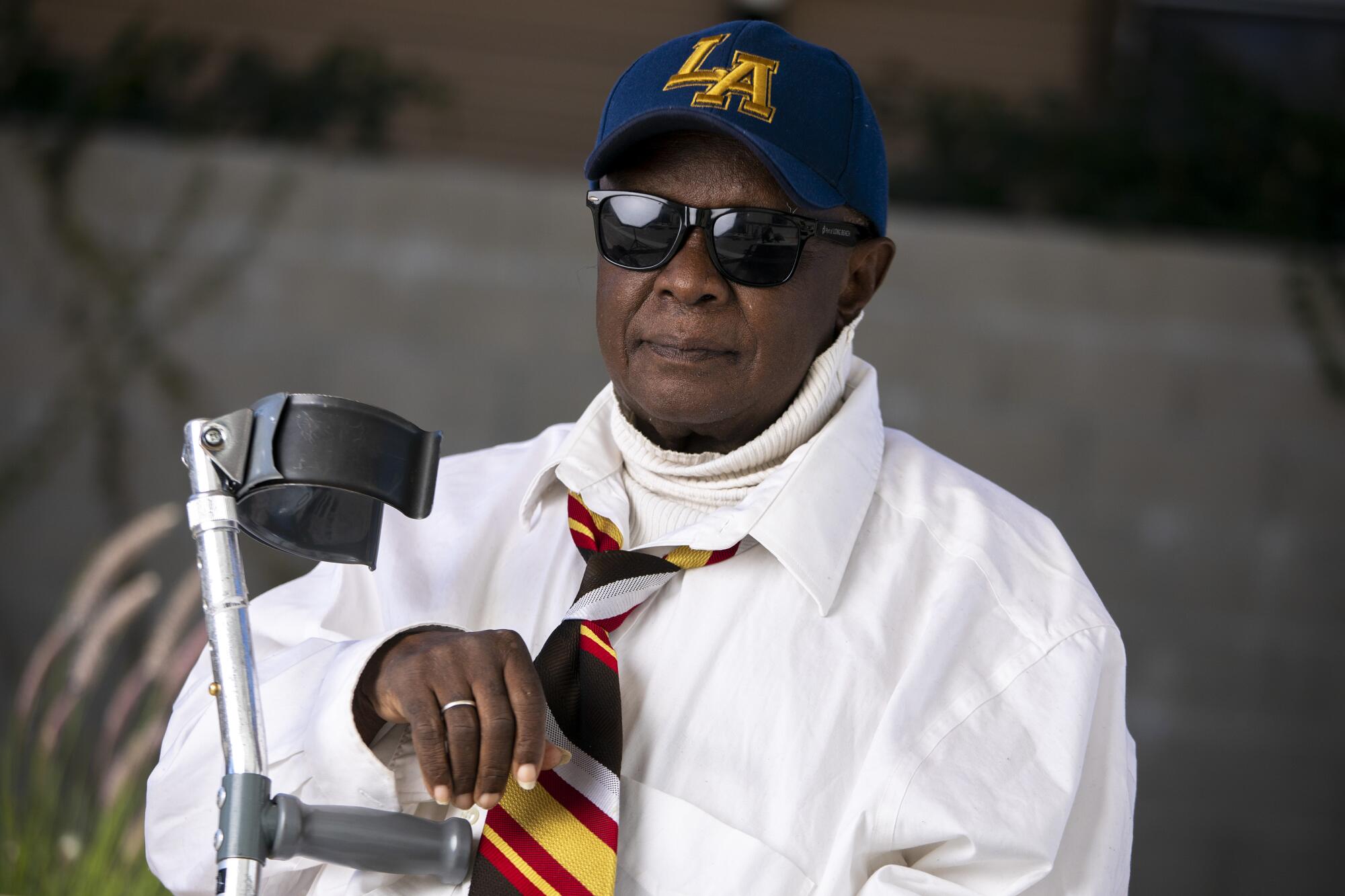
Johnsâ situation comes at a gold-rush moment for music publishing. Streaming has buoyed the recorded music industry and made older songs more accessible to fans, and thus the projected value of songwriting copyrights has skyrocketed. Superstars Bob Dylan and Paul Simon recently sold the rights to their songs to publishing giants Universal Music Publishing Group and Sony Music Publishing, respectively, for hundreds of millions of dollars. Meanwhile, the U.K.-based Hipgnosis Songs Fund has led the pack of heretofore lesser-known companies spending billions to purchase the songwriting catalogs of everyone from the Red Hot Chili Peppers to Carole Bayer Sager.
For hip-hop and EDM in particular, sampling has long scrambled the idea of who owns a song. Initially, hip-hop artists used it to freely mine music history to create new tracks on a budget. But after Irish singer-songwriter Gilbert OâSullivan sued rapper Biz Markie in 1991 for using a piece of his hit âAlone Again (Naturally),â the calculus changed in favor of the sampled act rather than the artist. Today, only well-financed artists can typically afford to sample prominent material.
Race, as always, complicates the ways artists lift or credit musical ideas. Itâs a story as old as vaudeville and Elvis, up through Led Zeppelin, Vanilla Ice, Madonnaâs âVogueâ and Diplo. European dance music is inseparable from the Black acts that white superstars often sample (like Avicii using Etta Jamesâ vocals on âLe7els,â which kicked off the EDM boom of the 2010s).
âThe question of musical ownership is a thorny one,â Lawrence said. âThe process of researching and selecting samples is one that requires musical knowledge and skill. If the sample is paid for, then the musician is arguably both paying homage as well as royalty fees. But when a privileged artist uses material from another artist, itâs only right that that material should be paid for.â
Jacobson agreed: âCreatorsâ rights have to be respected, and everybody should share in that income,â she said. âEspecially in a situation where the music is already being used.â
But determining what, exactly, Johns is owed two decades later will be complicated.
When an artist samples a record, they need permission from the owners of the master recording (usually a record label) and the owners of the songwriting (usually the writer or their publishing company). Sampling licenses are negotiated individually, and fees vary widely.
The song âMore Spell on Youâ is registered with Franceâs publishing agency SACEM, which administers royalty payments for songwriters. Johns is listed as âMore Spellâsâ main writer and performer, while Salesses is listed as a composer. (SACEM did not return requests for comment.)
Income from âOne More Timeâ would be subdivided between the various labels, publishing companies and the artists, depending on their agreements. âWhat part of that Eddie shares in, we donât know yet,â Jacobson said. âBut it does seem that Eddie should have some credit on the composition and the master side, which didnât get handled. Now itâs up to all the parties to remedy that.â
Missey, Johnsâ mix engineer, hopes Johns finally sees his share of the record they made. âI think that the profit from it should also benefit the first creators, who took the initial risks,â he said.
Daft Punk retired after a career of sold-out stadiums and Grammy-winning albums. Johns never expected anything close to that for himself. He just wants what he was always looking for in music â whatever bit of money heâs due, and the respect he sought for his work back then.
âI did always wonder if the song was a success or not,â he said. âI went on with my life in another direction. But I wish I had gotten paid. I would have been in a better state of mind. My mother would have been very happy. I always just wanted to impress her.â
Anousha Sakoui contributed additional reporting to this story.
More to Read
The biggest entertainment stories
Get our big stories about Hollywood, film, television, music, arts, culture and more right in your inbox as soon as they publish.
You may occasionally receive promotional content from the Los Angeles Times.
